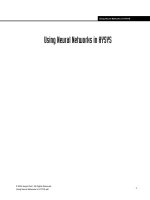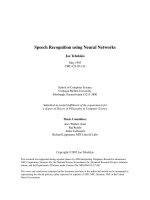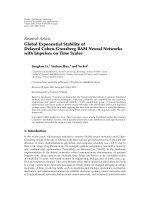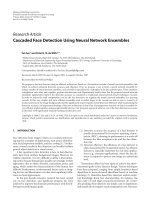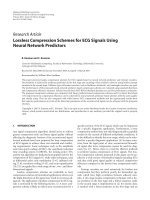landscape image of regional tourism classification using neural network
Bạn đang xem bản rút gọn của tài liệu. Xem và tải ngay bản đầy đủ của tài liệu tại đây (222.11 KB, 5 trang )
Landscape Image of Regional Tourism
Classification using Neural Network
Thai Hoang Le,
Computer Science Department,
University of Science
HCM City - Vietnam,
Nguyen Thai Do Nguyen,
Math and Computer Science
Department,
University of Pedagogy
HCM City - Vietnam,
Hai Son Tran,
Math and Computer
Science Department,
University of Pedagogy –
HCM City - Vietnam,
Abstract— In recent years, pattern classification and
image classification have received much attention. Many
approaches are suggested to solve these problems such as
Neural Network, Support Vector Machine, or K-NN. In
this paper, we improve Multi Artificial Neural Network
model to apply for Landscape Image of Regional Tourism
classification. This model evaluates the reliability of each
image space and gives the final classification conclusion.
In order to compare this method to others, we setup these
methods into a set of 904 landscape image of regional
tourism Ha Long, Ha Noi, Nha Trang. The classified
results show the feasibility of our improvement model.
Keyword: Neural Network, Multi Artificial Neural
Network (MANN), Image Classification.
I. INTRODUCTION
Landscape image of regional tourism classification
is a kind of pattern classification, which has large
pattern representation space. The k-nearest neighbor
(k-NN) decision rule is a common tool in image
classification but its sequential implementation is
slowly and requires the high calculating costs. Thus
using them to apply for landscape image of regional
tourism classification is not feasible. While SVM may
be errors in the case of the landscape is not in all region
tourism, because SVM will classify it into the nearest
regional tourism based on the calculation parameters.
Therefore, we use Neural Network to apply for
landscape image of regional tourism classification.
In this paper, we improve the Multi Artificial
Neural Network (MANN) model to apply for
landscape image classification. Firstly, landscape
images projected to difference representation spaces.
Secondly, based on one-by-one spaces, landscape
images are classified
into responsive regional tourism
class using a Neural Network called Sub Neural
Network (SNN) of MANN. Lastly, we use MANN’s
to compose the classified result of all SNN.
II. MULTI
ARTIFICIAL
NEURAL
NETWORK
IMPROVEMENT
APPLY
FOR
IMAGE
CLASSIFICATION
Multi Artificial Neural Network (MANN), applying
for pattern or image classification with parameters
(m,L), has m Sub-Neural Network (SNN) and a global
frame (GF) consisting L Component Neural Network
(CNN). In particular, m is the number of feature
vectors of image, n is the number of feature vector
dimensions and L is the number of classes. MANN
model has suggested 4 definitions (SNN, GF,
Collective vector R, and CNN. [1]
Figure 1. MANN (m,L)[1]
In this paper we have some improvements below:
Improvement 1: All SNN have n input nodes. N is
the dimensions of feature vector. It means that all sub
presentation space of landscape image has n
dimensions and equivalent each other. Besides, all
SNN will be the same structure. So the implementation
costs will be reduced and MANN (m,L) becomes
MANN (m,,n,L).
Improvement 2: The local training phase can be
done parallel. It means that SNN
1
,
SNN
2
… SNN
m
are
trained in the same time, see Fig. 2.
Figure 2. Parallel
local training
III. LANDSCAPE
IMAGE
OF
REGIONAL
TOURISM
CLASSIFICATION
PROBLEM
A. Feature Extraction from Image
In the above section, we explain the MANN in the
general case with parameters (m,n,L) apply for pattern
classification. Now we apply improvement MANN
model for landscape image of regional tourism
classification. In fact this is an experimental setup with
(m=4,n=5,L=3). The training image set has 822 images
including 201 Ha Long bay images (getting from
Internet), 367 Ha Noi images and 254 Nha Trang
images (capture by digital camera). The test set has 82
images of Ha Long, Ha Noi, Nha Trang.
Because the input of Neural Network is vector data,
an image is extract to m feature vectors [2],[8]. In
details, the image separate into 4 sub-image based on
gray level, see Fig. 3. Firstly, image is extract to
background and foreground. Foreground includes the
pixels which has higher gray level. Background
includes the pixels which has lower gray level.
Foreground will be extracted to Fore of Foreground
and Back of Foreground based on gray level.
Background will be extracted to Fore of Background
and Back of Background based on gray level.
Figure 3. Image feature extraction
Each of sub-images is extract the position of center
(upper left (UL), upper right (UR), lower left (LL),
lower right (LR) quarter), the ratio of sub-image’s area
and use LHC color [3] instead of RGB color.
1
3
0
*
1
*
* 2 * 2
1 1
3 3
*
0 0
1 1
3 3
0 0
1 1 6 1 6
tan
( ) ( )
5 0 0
* 2 0 0
2 .7 6 9 0 1.7518 1 .1 3 0 0
1 .00 0 0 4 .59 0 7 0 .0 6 0 1
0 .00 0 0 0 .0 5 6 5 5 .59 4 3
Y
L
Y
b
H
a
C a b
X Y
a
X Y
Y Z
b
Y Z
X
Y
Z
−
= −
=
= +
= −
= −
=
R
G
B
(
1
)
Thus, an image is featured by 4 vectors has 5
dimensions. For example, Fig. 4 will be extracted to 4
feature vectors in the Table 1.
Figure 4. A landscape image
Table 1. An image features
Sub
Image Pos
Ratio
area L H C
1 LL 0.26 159 0.59 4.53
2 UR 0.33 226.8 0.42 0.92
3 UR 0.33 56.0 0.66 9.15
4 UR 0.08 116.4 0.75 6.61
B. MANN Architecture apply for Landscape Image of
Regional Tourism
An image is a pattern featured by 4 vectors which
have 5 dimensions. Images need to classify into 3
classes (Ha Long, Ha Noi, Nha Trang). So we apply
MANN with parameters (m=4,n=5,L=3) for landscape
image of regional tourism classification.
Thus, MANN model in this case has four SNN(s)
and one GF consisting of three CNN(s). The i
th
(i=1 4)
feature vector of an image will be processed by SNN
i
in order to create the L=3 dimensional output vector of
responsive SNN. To join all the k
th
(k=1 3) element of
these output vectors gets the collective vector R
k
.
These collective vectors are the input of CNN(s). The
only one output node of CNN is an output node of
MANN, see Fig. 5.
Figure 5. MANN architecture with (m=4,n=5,L=3)
In our implementation uses back-propagation
Neural Network which has 3 layers with the transfer
function is sigmoid function [4] for SNN and CNN.
The number of hidden nodes of SNN
i
(i=1 4) and
CNN
j
(j=1 3) are experimentally determined from 1 to
10 hidden nodes.
Every SNN
i
has n=5 (the dimensions of feature
vector) input nodes and L=3 (the number of classes)
output nodes. The k
th
(k=1 3) output of the SNN
i
gives
the probability of image in the k
th
class based on the i
th
feature vector.
Every CNN
j
has m=4 (the number of feature
vectors) input nodes and only one output nodes. Input
of CNN
j
is the j
th
output of all SNN(s). It means that
CNN
j
compose the probability of image in the j
th
class
appraised by all SNN(s). Output of CNN
j
is the j
th
output of MANN model. It gives the probability of
image in the j
th
class. It is easy to see that to build
MANN model only use Neural Network technology to
develop our system.
IV. R
ESULTS
We use the same 904 (include 822 for training and
82 for testing by reference the 10-Fold statically
method) images set to classify. We compare our
improvement MANN model to selection method
(choose only one Sub-Neural Network result), and
original MANN.
The experimental classified result uses a SNN,
original MANN and improvement MANN in the same
image database could be seen in the Table 2.
Table 2. The experimental classified result
Region
SNN
1
SNN
2
SNN
3
SNN
4
MANN
MANN
Improvement
Ha
Long 13 13 14 12 16 15
Ha
Noi 17 21 22 20 24 22
Nha
Trang 16 15 10 12 15 22
Total 46 49 46 44 55 59
The above table show the details of classified result
based on one by one Sub Neural Network (SNN
1
,
SNN
2
, SNN
3
, SNN
4
), the original model (MANN) and
the improvement model. The trend of experiment
result show in the Fig. 6.
Figure 6. Classified result with different methods
It is easy to see that our improvement model has
increased the classified result. Besides, the
improvement model will have lower implementation
costs than original model and can be trained parallel.
V.
C
ONCLUSION
In this paper, we have improved Multi Artificial
Neural Network (MANN) with parameters (m,n,L)
from MANN (m,L), where m is the number of feature
vectors of pattern or image, n is the dimensions of the
feature vector, and L is the number of classes. This
model applies for landscape image classification.
MANN model has m Sub-Neural Network SNN
i
(i=1 m) and a Global Frame (GF) consisting L
Components Neural Network CNN
j
(j=1 L). Each of
SNN uses to process the responsive feature vector.
Each of CNN uses to combine the responsive element
of SNN’s output vector. In fact, the weight coefficients
in CNN
j
are as the reliability coefficients the SNN(s)’
the j
th
output. So the importance of the feature vectors
is identified after the training process. On the other
hand, it depends on the image database and the desired
classification.
To experience the feasibility of improvement
MANN model, in this research, we conducted to
develop a improvement MANN model with parameters
(m=4,n=5,L=3) apply for landscape image of regional
tourism classification. The experimental result in the
same image database shows that the improvement
model increases the classified result more than the
selection and original MANN method.
VI. R
EFERENCES
[1] Thai, L., Hai, S. T., Facial Expression Classification
Based on Multi Artificial Neural Network, Volume of
Extended Abstract, International conference on Advance
Computing and Applications, Mar 2010, p. 125-133.
[2] Thai, L. Building, Development and Application Some
Combination Models of Neural Network (NN), Fuzzy Logic
(FL) and Genetics Algorithm (GA), PhD Mathematics
Thesis, Natural Science University, HCM City, Vietnam,
2004.
[3] Siu-Yeng Cho and Zheru Chi, Genetic Evolution
Processing of Data Structure for Image Classification, IEEE
Transaction on Knowledge and Data Engineering, Vol 17,
No 2, 2005.
[4] Bishop, C.: Pattern Recognition and Machine Learning.
Springer Press, 2006
[5] Tong, S. and E. Chang, Support vector machine active
learning for image retrieval, Proceedings of the ninth ACM
international conference on Multimedia, 2001, p. 107-118.
Compare of image classification
0
0.1
0.2
0.3
0.4
0.5
0.6
0.7
0.8
SNN
1
SNN
2
SNN
3
SNN
4
MANN
MANN
Improve
ment
Methods
[6] Brown, R. and B. Pham, Image Mining and Retrieval
Using Hierarchical Support Vector Machines, Proceedings
of the 11th International Multimedia Modeling Conference
(MMM'05)-Volume 00, 2005, p. 446-451.
[7] Ghoshal, A., P. Ircing, and S. Khudanpur, Hidden
Markov models for automatic annotation and content-based
retrieval of images and video, Proceedings of the 28th
annual international ACM SIGIR conference on Research
and development in information retrieval, 2005, p. 544-551.
[8] Chen, Y. and J.Z. Wang, A region-based fuzzy feature
matching approach to content-based image retrieval, Pattern
Analysis and Machine Intelligence, IEEE Transactions on,
2002, p. 1252-1267.
[9] Hoiem, D., et al., Object-based image retrieval using the
statistical structure of images, Computer Vision and Pattern
Recognition, CVPR 2004, Proceedings of the IEEE
Computer Society Conference on, 2, 2004.


